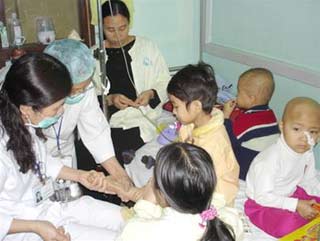Children with blood cancer: Add a chance to live
In August, the National Pediatric Hospital will perform the first marrow transplant. If a bone marrow and stem cell transplant are given, the patient will have a greater chance of improving the life, stabilizing the condition.
The disease is increasing

The National Hospital of Pediatric Oncology was assigned 25 beds, but in the past few months, the number of inpatient patients was always 50-60, accounting for more than two-thirds of the patients with blood cancer - Photo: N. Ha)
The National Pediatric Hospital chose a 7-year-old patient with severe myelosuppression for the first bone marrow transplant that will be performed in August. The donor is the sister of a pediatric patient, 13 years old. At that time, the National Pediatric Hospital is still the only facility of the country to implement this technique in treating pediatric patients.
Doctor Bui Thi Ngoc Lan, deputy head of oncology department, confirmed that marrow transplantation and stem cells will improve the quality of life for children with cancer, metabolic diseases, marrow failure, genetic diseases. . For patients with leukemia (leukemia), this application is very important because the rate of children suffering from diseases tends to increase in recent years.
According to Associate Prof. Dr. Nguyen Thanh Liem, director of the National Hospital of Pediatrics, about 10-20 years ago, the hospital used to treat only about 60 patients with leukemia each year. However, in 2005 alone there were about 300 children infected and that is just the number of hospital admission statistics. Hospital statistics show that 42% of cases in the oncology department are patients with leukemia. Even the oncology department is currently receiving treatment for more than 50 children (with 25 beds), accounting for more than two-thirds of them are patients with leukemia.
Last choice
Current treatment regimen for patients with leukemia in most establishments with specialized oncology for children is to use chemotherapy, in case of meningeal metastases, testicular metastases, supplement radiation therapy. The results of this method of treatment at the National Hospital of Pediatrics are 60% cured, mainly in patients with mild cancers of the blood.
When the child shows pale skin accompanied by subcutaneous hemorrhage, enlarged, enlarged liver and spleen can be considered as the first signs of disease diagnosis. In fact, the number of male patients with the disease is 1.5 times higher than that of women . Due to the complexity and high cost of bone marrow transplantation techniques (overseas costs are usually 25,000 USD / shift), So this will be the final treatment option.
Dr. Lan said the hospital will appoint a bone marrow transplant for patients with severe cancer who cannot use chemicals, or who have used chemotherapy but do not achieve the necessary stability, recurrence or risk of rapid recurrence. . Doctors will use powerful chemicals to destroy all cancer cells in the body, then take the donor source to transplant for the patient. Grafted cells will move into the bone marrow, then produce new blood cells to help patients heal.
Constituent source difficulties
The most difficult problem in marrow transplantation for patients is the source of donation. While people with a weight of over 20kg can transplant themselves, the patient with leukemia under the weight standard is required to find the appropriate marrow donation source and have a genetic structure similar to the patient so as not to occur. the rejection phenomenon after transplantation. The proportion of marrow compatible among relatives in the family is only about 25%, that rate in the community is many times lower.
In adults, stem cells have a lot of blood, so they can take initiative in blood. But for children, their stem cells contain only a small amount of blood, so it is necessary to have a specialized blood collection device. After marrow transplantation, patients need to take anti-infective drugs, while the risk of infection in children is much higher than adults.
NGOC HA
- Save a child from death's hand
- Living too clean makes children vulnerable to cancer
- Fukushima children have 20 times more cancer
- What is white blood disease?
- The US announced a successful trial of blood cancer drugs
- SoftBank and many other companies invest billions of money into cancer testing technology with blood
- New blood tests help detect 8 types of cancer
- An additional gene therapy for blood cancer is licensed in the United States
- Things to know about blood cancer
- In the tribe, nearly 50% of children cannot live more than 5 years in Africa
- Cancer does not need radiotherapy thanks to blood tests after surgery
- Blood test method helps detect cancer 5 years early
 Why is Australia the country with the highest cancer rate in the world while Vietnam ranks 100th?
Why is Australia the country with the highest cancer rate in the world while Vietnam ranks 100th? New drug causes cancer to 'starve'
New drug causes cancer to 'starve' Common cancers in men
Common cancers in men America's incredible discovery: The most feared cancer cell is love
America's incredible discovery: The most feared cancer cell is love